This post may contain affiliate links. Please read our disclosure policy.
Ackee and Saltfish, the national dish of Jamaica, is a beloved breakfast staple enjoyed throughout the Caribbean. This dish combines sautéed tomatoes, onions, sweet peppers, thyme, and scotch bonnet pepper with ackee and salted codfish. It’s perfect for breakfast, lunch, dinner, or any time of day.
For an authentic Jamaican breakfast, check out my list of Jamaican Breakfast Ideas.

There’s a reason why ackee and saltfish is the national dish of Jamaica! It’s an undeniably delicious combination of fresh, wholesome ingredients: soft ackee, and tender saltfish simmered with fresh peppers, onions, tomatoes, and thyme.
Growing up, this was a staple in our household. After you try this recipe, you’ll want to make it all the time too!
Table of Contents
- Here’s Why You’ll Love this Ackee and Saltfish Recipe
- Why do Jamaicans eat ackee and saltfish?
- What is Ackee?
- What Does Ackee Taste Like?
- What is Saltfish?
- How to Desalt Fish
- Ackee and Saltfish Ingredients
- How to Prepare Ackee and Saltfish
- Recipe Tips
- Recipe Substitutions and Variations
- Can I Make Ackee and Saltfish Ahead of Time?
- Storage Instructions
- Frequently Asked Questions
- Interested in more Jamaican Recipes? Check These Out!
- Ackee and Saltfish Recipe
Here’s Why You’ll Love this Ackee and Saltfish Recipe
- A Balanced Meal: This pescatarian dish combines vibrant veggies and fruit for a healthy meal. The ackee fruit offers fatty acids that reduce the risk of heart disease, while saltfish lowers blood pressure and promotes healthy skin.
- Quick and Easy: Aside from soaking time for the salted codfish, this recipe only requires a simple saute.
- Good Anytime: Enjoy saltfish and ackee morning, noon, or night! This versatile meal is a nutritious start to your day but filling enough for lunch or dinner.
Why do Jamaicans eat ackee and saltfish?
Jamaicans eat ackee and saltfish because these ingredients have deep historical roots on the island. Ackee was brought from West Africa, and saltfish was introduced during the colonial era as part of the triangular slave trade. The dish has since become a symbol of Jamaican culture and resilience, making it a beloved national dish today.
What is Ackee?
Ackee is a fruit that originates from Ghana. It grows on trees and can be poisonous if not harvested and prepared properly. The toxic seeds are removed from the fresh ackee and then it is boiled in salted water. Due to FDA restrictions, you won’t find fresh ackee outside of Jamaica. However, canned ackee is available in the United States, Canada, and the United Kingdom.


What Does Ackee Taste Like?
Although ackee resembles soft scrambled eggs, it tastes nothing like it. Ackee naturally has a light, nutty flavour. It is in the lychee family but is more savoury than sweet. This delicate fruit easily absorbs other flavours. Once cooked, it has a delightful, creamy consistency.
What is Saltfish?
Saltfish is salted dehydrated cod fish. This is referred to simply as saltfish in the islands, also known as salted cod, salt cod, bacalao, bacalhau or baccalà. It is a type of preserved meaty white fish that has been salt cured and dried until all the moisture has been extracted. Once cooked, it has a nice tender texture and a savoury, buttery flavour.
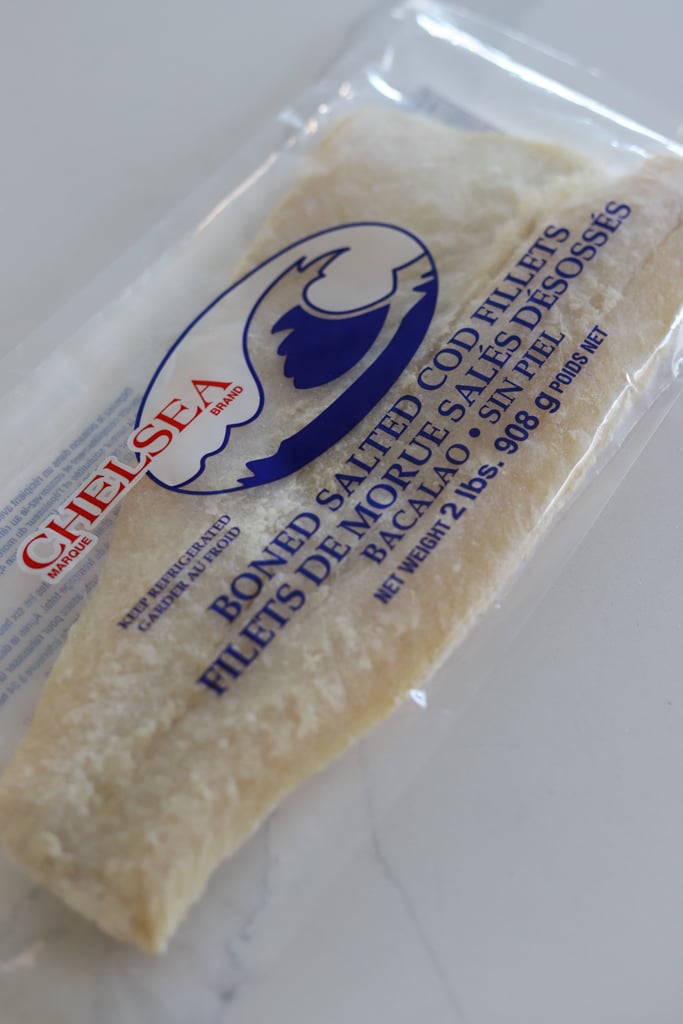
How to Desalt Fish
Desalting fish is essential to rehydrate it and reduce its salt content for cooking. The goal isn’t to remove all the salt, but to achieve a balanced flavour. There are several methods to do this.
- Cold Water Soak: Soak the fish in cold water in the refrigerator for 12-48 hours, changing the water periodically.
- Overnight Soak: Soak the fish in boiling water overnight, then boil it again if additional desalting is needed.
- Boiling: Boil the fish in water for 10-15 minutes, repeating the process if it’s still too salty.
- Cold Milk Soak: For a quicker method, soak the fish in cold milk for three hours, which eliminates the need for water changes.
After desalting, flake the fish and use it in your recipe.

Ackee and Saltfish Ingredients
- Ackee: Be sure to drain and rinse the canned ackee before adding it to the other ingredients.
- Saltfish: You can use boned or boneless saltfish.
- Onion: The sharp flavour pairs so well with the peppers.
- Peppers: I used a blend of orange bell pepper, red bell pepper, and scotch bonnet pepper. The bell peppers add a nice crunch, color, and sweetness whereas the scotch bonnet brings the heat.
- Tomato: Slice them into thin wedges. They lighten up this savoury meal.
- Fresh Thyme: Use fresh sprigs for an aromatic quality.
- Black Pepper: Use more or less to taste.
- Vegetable Oil: Opt for this or another high-heat oil. I use vegetable oil because it has a neutral taste and doesn’t overpower the other flavours. Avocado or coconut oil would work well too.
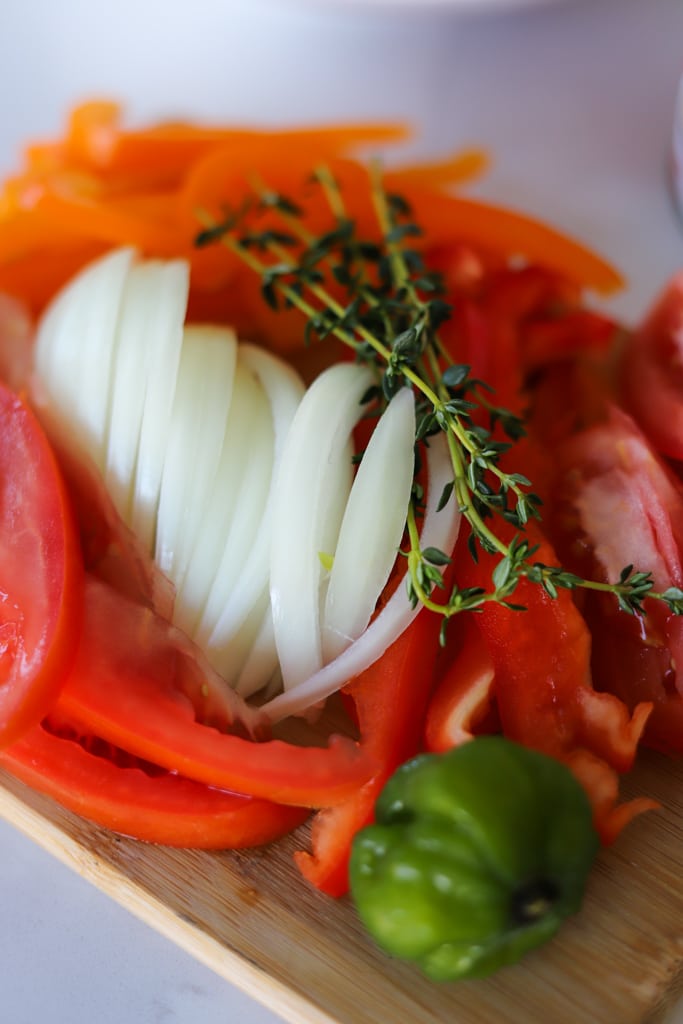
How to Prepare Ackee and Saltfish
1. Desalt Fish (Additional Methods Listed Above)
Fill a medium-sized pot with water and bring it to a boil. Rinse fish, cut it into smaller pieces, and boil for about 10 to 15 minutes. Drain then rinse in cold water. Taste a piece of the fish to gauge the saltiness. If it’s to your liking, pick it apart into smaller bite-sized pieces and set it aside. If it’s too salty, repeat the process.

2. Prep Ackee
Remove ackee from the can and drain the liquid using a strainer. Then, rinse with cool water, drain again then set aside.
An optional step is to bring a pot of water to a boil. Add ackee and let it sit for about 3 minutes or until the ackee starts to float. Then drain and set it aside.

3. Saute Vegetables and Aromatics
Heat oil in a large skillet over medium-high heat. Add the onion, bell peppers, tomatoes, thyme, and scotch bonnet pepper and saute until tender, crisp, and aromatic. This should take about 5 minutes.


4. Add Saltfish and Ackee
Add the saltfish and continue to saute for about 2 minutes. Then, gently fold in the ackee, being careful not to overmix as this will make the ackee break apart and become mushy. Cook until the ackee and saltfish are fully heated through. Season with black pepper to taste, and serve hot.


Recipe Tips
If you are concerned about your salt intake or don’t have access to salted codfish, consider using fresh cod instead.
Saltfish usually doesn’t require added salt but if you soak the saltfish overnight, you may have to add some salt back to the fish. Taste test after soaking.
Remove the seeds of the scotch bonnet pepper if you prefer a more mild flavour because it is especially spicy. Or you can skip it altogether.
Remove the seeds of the scotch bonnet pepper if you prefer a more mild flavour because it is especially spicy. Or you can skip it altogether.
When soaking the fish, place it skin side up (if using skin on saltfish) so the salt will be removed more easily.
Ackee is added just before the dish is complete because the fruit is very soft. If it cooks for too long, it may become mushy so avoid over-stirring.
Recipe Substitutions and Variations
- For a more savoury dish, consider adding bacon or ham.
- For a vegan alternative, swap the saltfish for jackfruit, heart of palm, or completely omit the saltfish.
Can I Make Ackee and Saltfish Ahead of Time?
Ackee and saltfish are best served fresh off the stove but you can definitely prepare parts of the recipe ahead of time. To save time, soak the cod overnight, drain and rinse it. You can also debone it prior to cooking. The prepared fish can be stored in the fridge for up to one week or frozen for up to 6 months.
Storage Instructions
Store leftover ackee and saltfish in an airtight container in the fridge and consume within 3 days. Don’t freeze ackee and saltfish because it alters the texture of the dish.
Reheat leftovers in a skillet over medium heat. Remember to stir it sparingly to avoid overmixing.
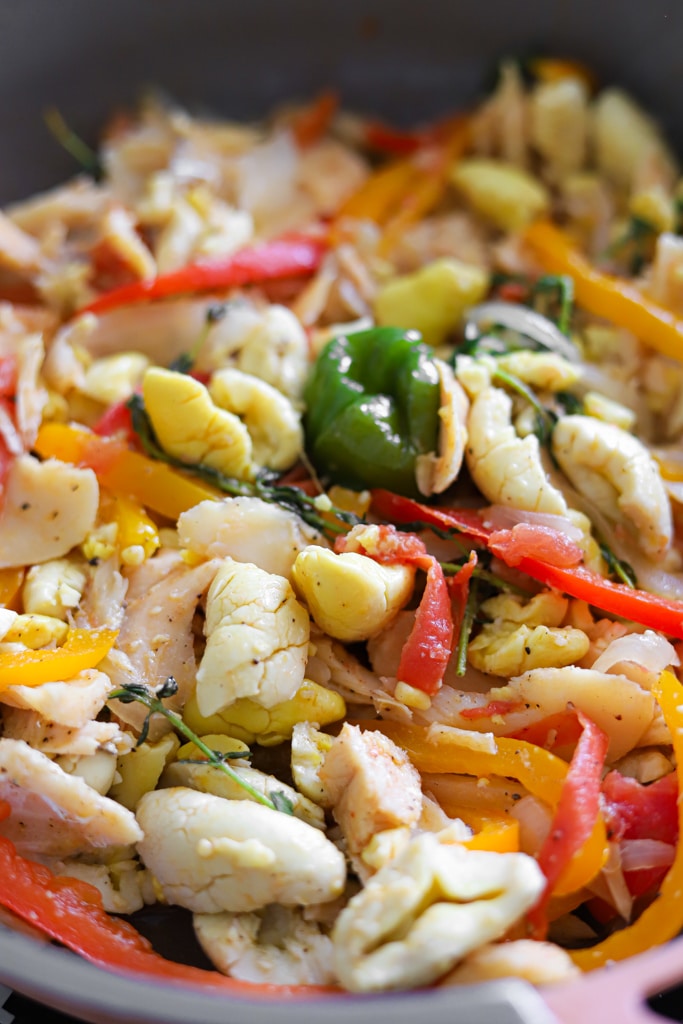
Frequently Asked Questions
You can find canned or frozen ackee in most international and Caribbean markets. You can also order it online.
You can enjoy it as is or serve with sliced avocados, fried dumpling, festival, breadfruit, white rice, ground provision or plantains. The options are endless!
Ackee can be eaten as part of a healthy diet. It is rich in nutrients, including protein, fiber, vitamins, and minerals.
Eating unripe ackee can be dangerous, as it contains a poison called hypoglycin that causes vomiting and can be fatal. However, it is completely safe to eat once ripened and properly prepared for cooking.
Interested in more Jamaican Recipes? Check These Out!
- Brown Stew Fish
- Jamaican Oxtail Recipe
- Jamaican Red Peas Soup
- Jamaican Chicken Soup
- Jerk Chicken Sandwich
- How to Soak Fruit for Christmas Cake
- Easy Jamaican Pigeon “Gungo” Peas and Rice
- Jamaican Pickled Vegetables (Escovitch Sauce)
- Jamaican Curry Shrimp (Seafood)
- Jamaican Rasta Pasta
- Quick & Easy Jamaican Jerk Chicken
If you try this Ackee and Saltfish recipe, we’d greatly appreciate if you leave us a star ★ rating, as well as some feedback in the comment section below if you found this blog post helpful and tasty!
Also, please use the hashtag #theseasonedskillet on social media for a chance to be featured, and don’t forget to keep up with TSS on Facebook, Twitter, Instagram, TikTok and Pinterest!
Lastly, sign up to our Friday weekly newsletter for the latest TSS updates, blog posts and recipes straight to your inbox.
Oh, and share, share, share with your family and friends!

Ackee and Saltfish
Equipment
- 1 Large Skillet
- 1 Fine Strainer
- 1 Wooden Spoon
Ingredients
- 1 440ml Can Ackee, drained
- 1 lb Salted Cod Fish, saltfish
- 1/2 med Onion, julienned
- 1/4 Orange Bell Pepper, julienned
- 1/4 Red Bell Pepper, julienned
- 1 sm Tomato, sliced into thin wedges
- 3 sprigs Fresh Thyme
- 1 Scotch Bonnet Pepper
- 1/4 tsp Black Pepper, more or less to taste
- 2 tbsp Vegetable Oil
Instructions
Desalt Fish (Additional Methods Listed Above)
- Fill a medium sized pot with water and bring to a boil. Rinse fish, cut into smaller pieces, and boil for about 10 to 15 mins. Drain then rinse in cold water. Taste a piece of the fish to gauge the saltiness. If it's to your liking, pick it apart into smaller bite-sized pieces and set aside. If it's too salty, repeat the process.
Prep Ackee
- Remove ackee from can and drain off liquid using a strainer. Then, rinse with cool water, drain again then set aside. Optional, bring to a boil a pot of water. Add ackee, let sit for about 3 minutes or until ackee starts to float, then drain and set aside.
Ackee and Saltfish
- Heat oil in a large skillet over medium high heat. Add the onion, bell peppers, tomatoes, thyme, scotch bonnet pepper and saute until tender crisp and aromatic, about 5 minutes.
- Add the saltfish and continue to saute for about 2 minutes. Then, gently fold in ackee, being careful not to overmix as this will make the ackee break apart and become mushy. Cook until the ackee and saltfish are fully heated through. Season with black pepper to taste, and serve hot.

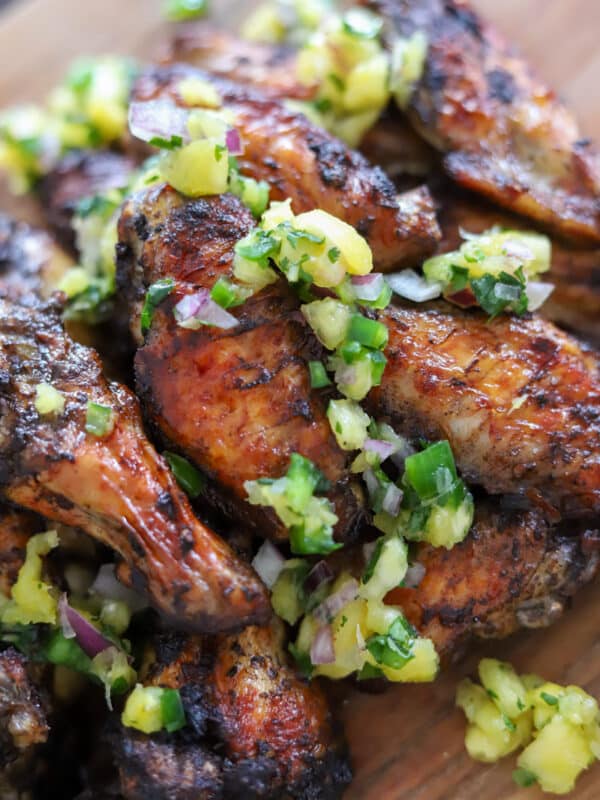
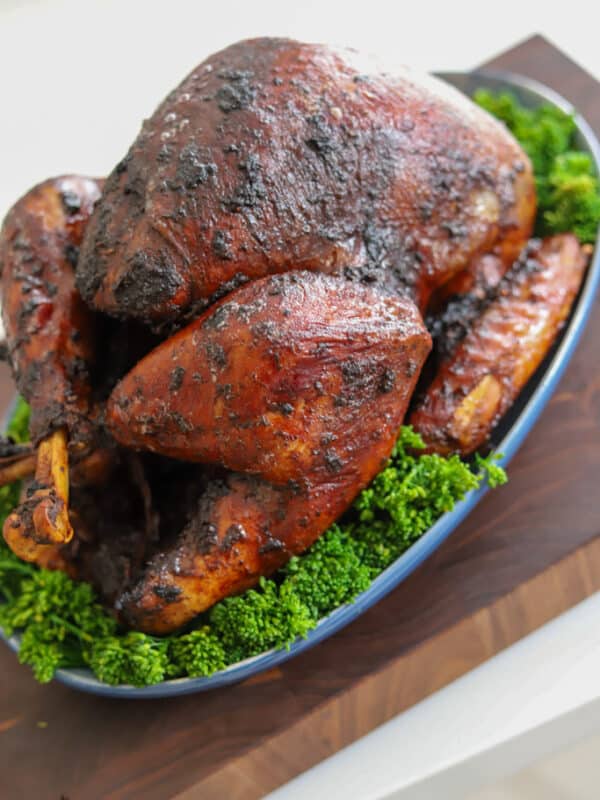
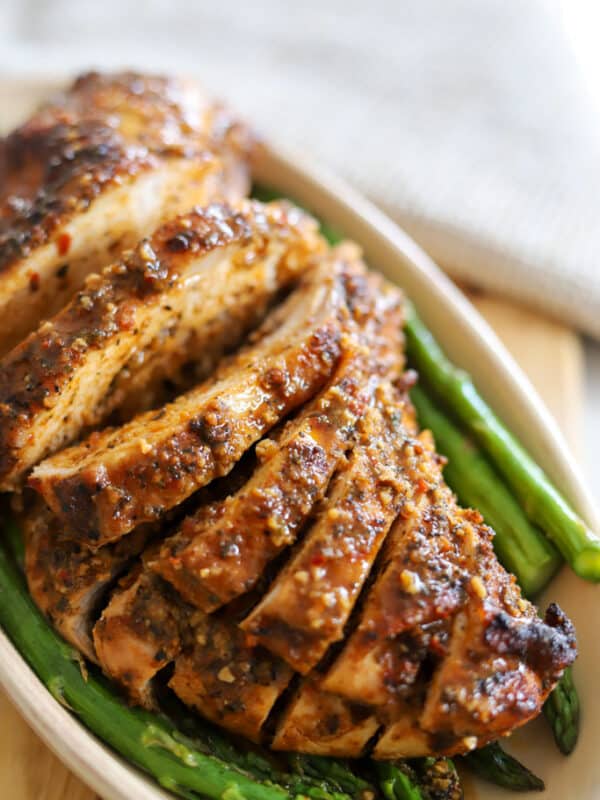
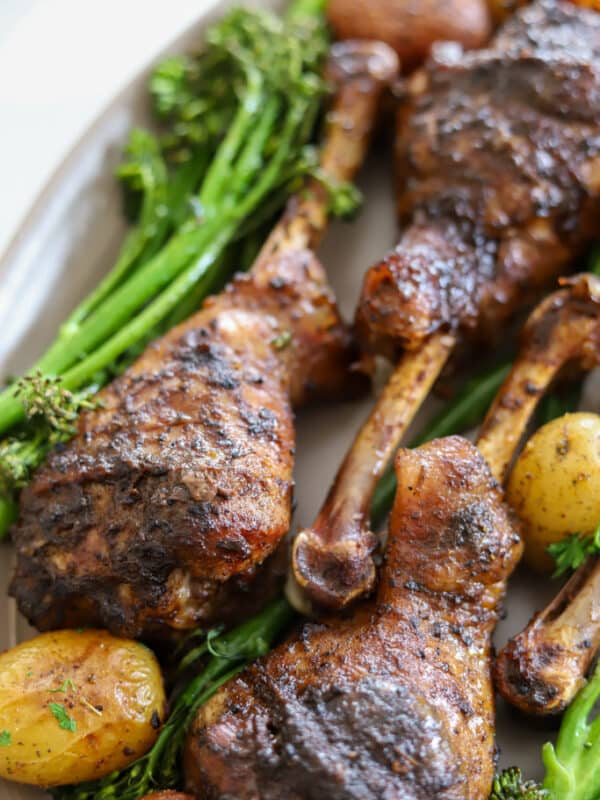








As a Rasta, and before I became a vegan Rasta, ackee and saltfish was my go-to meal. I love your version as it reminds me of my bredren and sistren who I used to enjoy this meal with.
Love to hear it Marta! So glad it brought you back to good times with your brothers and sisters! Yes!! Love it!
I’m thrilled to finally learn how to properly prepare this dish. Your instructions were clear and the results were spectacular! My taste buds thank you.
I have not had ackee and saltfish in forever and I’ve never tried making it myself at home, but your instructions made the process so simple! This is loaded with so much flavor and absolutely delicious!
Thank you for the step by step instructions and helpful pictures! This was my first go at ackee and saltfish and it came out wonderfully!